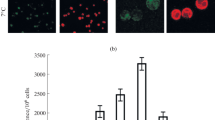Abstract
The response of aerobically grown Escherichia coli cells to the cold shock induced by the rapid lowering of growth temperature from 37 to 20°C was found to be basically the same as the oxidative stress response. The enhanced sensitivity of cells deficient in two superoxide dismutases, Mn-SOD and Fe-SOD, and the increased expression of the Mn-SOD gene, sodA, in response to cold stress were interpreted as both oxidative and cold stresses are due to a rise in the intracellular level of superoxide anion. The long-term cultivation of E. coli at 20°C was also accompanied by the typical oxidative stress response reactions—an enhanced expression of the Mn-SOD and catalase HPI genes and a decrease in the intracellular level of reduced glutathione (GSH) and in the GSH/GSSG ratio.
Similar content being viewed by others
References
Demple, B., Regulation of Bacterial Oxidative Stress Genes, Annu. Rev. Genet., 1991, vol. 25, pp. 315–337.
Jones, P.G., Van Bogelen, R.A., and Neidhardt, F.C., Induction of Proteins in Response to Low Temperature in Escherichia coli, J. Bacteriol., 1987, vol. 169, pp. 2092–2095.
Freeman, M.L., Spitz, D.S., and Meredith, M.J., Does Heat Shock Enhance Oxidative Stress? Studies with Ferrous and Ferric Iron, Radiat. Res., 1990, vol. 124, pp. 288–293.
Privalle, C.T. and Fridovich, I., Induction of Superoxide Dismutase in Escherichia coli by Heat Shock, Proc. Natl. Acad. Sci. USA, 1987, vol. 84, pp. 2723–2726.
Tao, K., Makino, K., Yonei, S., Nacata, A., and Shinagawa, H., Molecular Cloning and Nucleotide Sequencing of oxyR, the Positive Regulatory Gene of a Regulon for an Adaptive Response to Oxidative Stress in Escherichia coli: Homologies between OxyR Protein and a Family of Bacterial Activator Proteins, Mol. Gen. Genet., 1989, vol. 218, pp. 371–376.
Miller, J.H., Experiments in Molecular Genetics, Cold Spring Harbor: Cold Spring Harbor Lab., 1972. Translated under the title Eksperimenty v molekulyarnoi genetike, Moscow: Mir, 1976, p. 463.
Beers, R.F. and Sizer, I.W., A Spectrophotometric Method for Measuring the Breakdown of Hydrogen Peroxide by Catalase, J. Biol. Chem., 1952, vol. 196, pp. 133–140.
Tietze, F., Enzymic Method for Quantitative Determination of Nanogram Amounts of Total and Oxidized Glutathione: Applications to Mammalian Blood and Other Tissues, Anal. Biochem., 1969, vol. 27, pp. 502–522.
Lowry, O.H., Rosebrough, N.J., Farr, A.L., and Randall, R.J., Protein Measurement with the Folin Phenol Reagent, J. Biol. Chem., 1951, vol. 193, pp. 265–275.
Triggs-Raine, B.L. and Loewen, P.C., Physical Characterization of the katG Encoding Catalase HPI of Escherichia coli, Gene, 1987, vol. 52, pp. 121–128.
Carlioz, A. and Touati, D., Isolation of Superoxide Dismutase Mutants in Escherichia coli: Is Superoxide Dismutase Necessary for Aerobic Life?, EMBO J., 1986, vol. 5, pp. 623–630.
Touati, D., Jacques, M., Tardat, B., Bouchard, L., and Despied, S., Lethal Oxidative Damage and Mutagenesis Are Generated by Iron in the Δfur Mutants of Escherichia coli: Protective Role of Superoxide Dismutase, J. Bacteriol., 1995, vol. 177, pp. 2305–2314.
Gonzälez-Flecha, B. and Demple, B., Homeostatic Regulation of Intracellular Hydrogen Peroxide Concentration in Aerobically Growing Escherichia coli, J. Bacteriol., 1997, vol. 179, pp. 382–388.
Oktyabrsky, O.N., Golyasnaya, N.V., Smirnova, G.V., Demakov, V.A., Posokhina, N.Kh., and Kholstova, T.A., Acidification of Escherichia coli and Salmonella typhimurium Cytoplasm Reduces the Mutagenic Effect of N-Methyl-N'-Nitro-N-Nitrosoguanidine, Mutat. Res., 1993, vol. 293, pp. 197–204.
Oktyabrsky, O.N. and Smirnova, G.V., Changes in the Redox Potential of Escherichia coli Culture and in Intracellular Glutathione Status under Osmotic Shock, Bioelectrochem. Bioenerg., 1993, vol. 326, pp. 287–294.
Panoff, J.-M., Thammavongs, B., Güeguen, M., and Boutibonnes, P., Cold Stress Responses in Mesophilic Bacteria, Cryobiology, 1998, vol. 36, pp. 75–83.
Smirnova, G.V., Muzyka, N.G., Glukhovchenko, M.N., and Oktyabrsky, O.N., Effects of Menadione and Hydrogen Peroxide on Glutathione Status in Growing Escherichia coli, Free Rad. Biol. Med., 2000, vol. 28, no. 7, pp. 1009–1016.
Shiloach, J. and Bauer, S., High-Yield Growth of E. coli at Different Temperatures in a Bench-Scale Fermentor, Biotechnol. Bioeng., 1975, vol. 17, pp. 227–239.
Gel'man, N.S., Lukoyanova, M.A., and Ostrovskii, D.N., Membrany bakterii i dykhatel'naya tsep' (Bacterial Membranes and Respiratory Chain), Moscow: Nauka, 1972, p. 246.
Imlay, J.A. and Fridovich, I., Superoxide Production by Respiring Membranes of Escherichia coli, Free Rad. Res. Commun., 1991, vols. 12–13, pp. 59–66.
Author information
Authors and Affiliations
Rights and permissions
About this article
Cite this article
Smirnova, G.V., Zakirova, O.N. & Oktyabrskii, O.N. The Role of Antioxidant Systems in the Cold Stress Response of Escherichia coli. Microbiology 70, 45–50 (2001). https://doi.org/10.1023/A:1004840720600
Issue Date:
DOI: https://doi.org/10.1023/A:1004840720600




